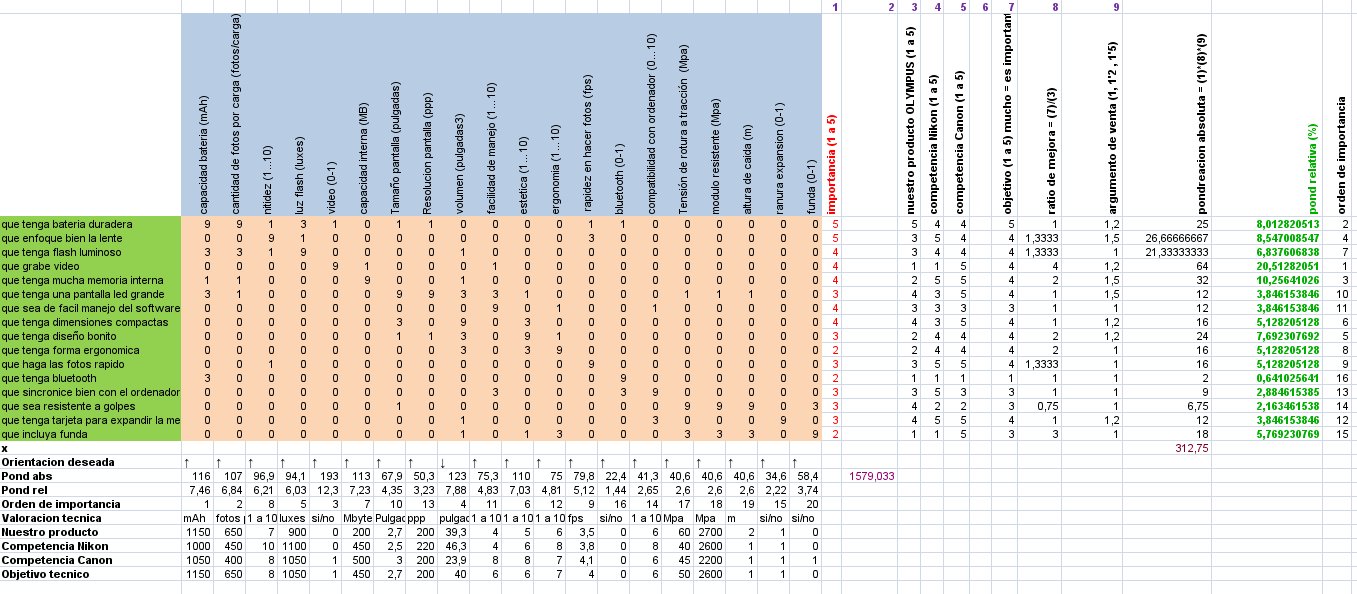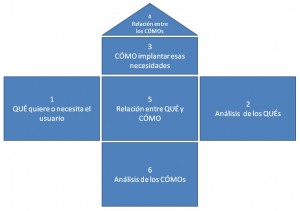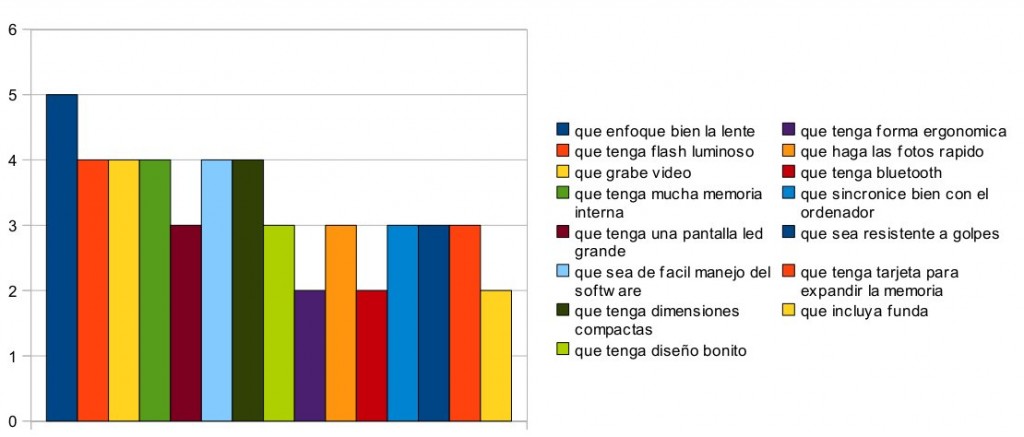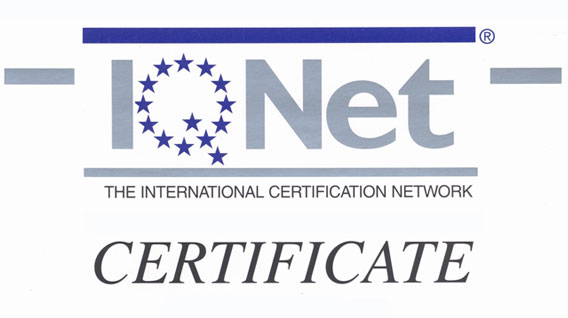Quality Function Deployment (QFD): What is QFD and how to use it
The Quality Function Deployment, also called The House of Quality, is a methodology used in design and quality engineering to create products that suit the desires and needs of the client/customer of them. Thus, with QFD we will be able to calculate what features should be added to the design of our product or service. Also, we will know what are the unnecessary features that add an extra cost to the product without being appreciated by the customer and give us a vision about how is our product placed in the market, in order to choose which are the priority areas to improve.
In summary, the Quality Function Deployment (QFD) help us when we have to design a new product:
– QFD gives us an objective point of view about what our future customers are looking for in a product and the requirements it must have.
– QFD gives us a prioritization about what features are most important to add, and which ones are not necessary.
– QFD tell us about the situation of how is our current product against similar others, and what are the areas of improvement to be more competitive (and sell more, of course).
In this post we will explain the steps to apply this methodology.
You also have an example of a QFD in the end of the post to download it.
Generally, QFD has this shape:
To do this, you have to follow the order indicated in the drawing. To explain it step by step, we will take an example of a fictional company that wants to launch a new digital camera:
1. “WHAT” List
The WHAT List includes the aspects that our clients and customers expects from our product. At this point you have to put as many things as you can, in order to not forget any aspect. Later, we will discard the WHAT points less relevant.
For example, for a digital camera we could write those WHAT points:
The camera should have…
a good battery
a hight quality lens
flash light
it has to be able to record video
a big internal memory
a large LED display
a easy to use software
a compact design
a pretty design
a ergonomic shape
it has to take photos quickly
bluetooth
it has to be able to synchronize with the computer
resistant to shocks
it has to be able to expand it with a memory card
it should come with a cover
2. WHAT Analysis
Now, the first thing to do is to order the WHAT points by its importance. In order to do it, you can create a quest or survey of potential users /clients/customers, which rate the importance of each aspect from 1 to 5 (1 = not important, 5 = very important).
These results of importance have to be written in one column (column 1) in an Excel and they will be used later.
The next columns to fill are those about what is the current status of our product for each WHAT (column 3) and how are the other companies (columns 4 and 5), filling them with values between 1 and 5 for each WHAT, (1 = very bad situation and 5 = very good situation). For example, if our product does not have Flash, you will receive a 1 in that box, and if you have very good flash will be a 5. (See the example below).
Once that it’s done and based on the importance of each WHAT, you have to put an objective or goal between 1 and 5, which will we placed in the next column (6).
Now we calculate the improvement ratio (column 8) by dividing the current status of each WHAT with your goal (column 8 = column 7 / column 3).
The following to fill is the column of the marketing “sales pitch” (column 9). Here, you will get a value between 1 and 1.5 if the mentioned WHAT is a good sales pitch (1 = bad, 1.5 = good pitch). With this, we have included in our design not only the customer preferences (that are in column 1) but also ours preferences as a company.
The next task is to calculate the absolute weight in the next column, as the multiplication between the importance (column 1), the improvement ratio (column 8) and the sales pitch (column 9). We can also take the relative weight in percentage and absolute weight of each WHAT divided by the sum of the absolute weights.
Once we know what are the most important aspects to improve, we can look the weight of each WHAT and we can implement only those who have more weight, discarding others less important.
3. HOW List
After considering what has to have our product, the next step is to define the technical requirements to obtain it. So we will create a HOW List with the features that must have our product.
For example, for the digital camera:
for a good battery -> Battery capacity (mAh) and amount of shots per charge (photos / charge)
for a hight quality lens -> quality (1 … 10)
for flash light -> flash light included (0 = no, 1 = yes) and luminosity (lux)
for be able to record video -> (0 = no, 1 = yes)
for a big internal memory -> Internal memory capacity (MB)
for a large LED display -> Screen Size (inches) and Screen Resolution (dpi)
for a easy to use software -> accessibility (1 … 10)
for a compact design -> volume (cm ^ 3)
for a pretty design -> design (1 … 10)
for a ergonomic shape -> ergonomics (1 … 10)
for taking photos quickly -> speed in taking photos (fps)
bluetooth -> (0 = no, 1 = yes)
for be able to synchronize with the computer -> compatibility with Windows/Linux/Mac (0 = no, 1 = yes)
for be resistant to shocks -> strength (1 … 10)
fo be able to expand it with a memory card -> (0 = no, 1 = yes)
come with a cover -> cover included (0 = no, 1 = yes)
Note that beside each feature is included its measuring scale.
4. Relationship between the HOW points
This is the famous triangle (or roof) that is above the QFD shape, by which this method is also called the House of Quality.
This triangular matrix relates the HOW points between themselves. The relationships can be positive, negative or zero (eg: flash have much negative impact on the battery). This part of the QFD is optional and it’s not usual to put it unless the interactions are very strong,
5. Relationship between WHAT and HOW points
This matrix is in center of the QFD and serves to link the WHAT ant the HOW aspects. With this, we will translate the abstract aspects of the list of measurable characteristics “WHAT” to the HOW list.
To do this we will classy from 1 to 9 the relationship between each WHAT and each HOW. For example, “to have a good battery” and “battery capacity (mAh)” have a 9 because they are closely linked, but has a 1 with “strength (1 … 10)” because they have no relationship.
Note: It is crucial to verify that all major WHAT are connected with one or more HOW, since otherwise we would have issues not contemplated.
Once completed this, the aspect of our QFD will be like this (click on the image to enlarge it):
6. HOW analysis
It only remains to fill in the last part of our QFD, which calculates the technical objectives we need to finally obtain the specifications required by our product:
Here we have first fixed the desired orientation of each HOW (more value = better or more value = worst). For example, in a digital camera, more internal memory is better, but more weight is worse.
The following is to calculate the absolute and relative weight of each HOW. For each HOW is calculated: absolute Weight = Sum (Value of each relationship between WHAT and HOW * Relative Weight associated with the WHAT). From here we will get the order of importance of each of the technical aspects.
Finally, we fill what are the technical aspects of our product and the technical aspects of the other companies product, and we will set what are the characteristics that will be implemented in our product taking into account the relevance of each feature weight, and also, taking into account the situation of the other companies in each of the characteristics.
The end result will be as follows:
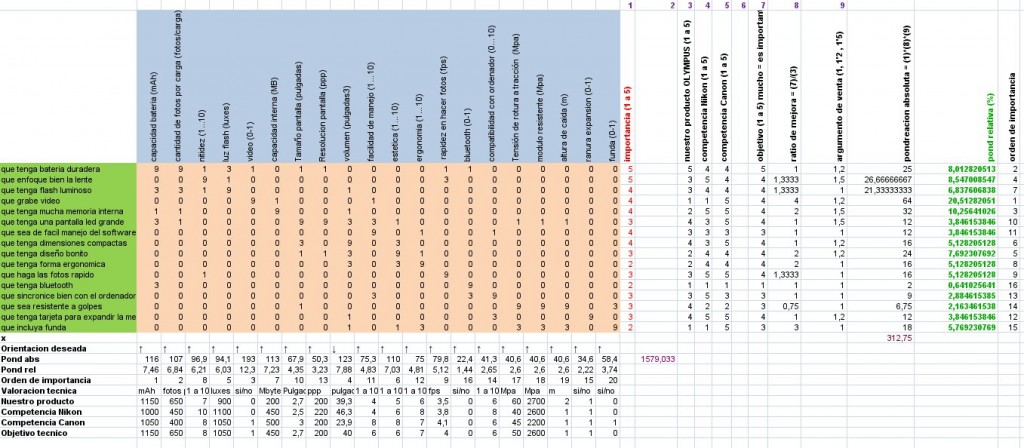
Download excel sample file here: Download QFD example
Conclusion
With QFD analysis we have achieved the next goals:
– To prioritize what our customers want.
– To know what are the essentials you should put in your product and what are the superfluous aspects that you can remove without losing sells.
– To have a vision about your situation in the market, and to compare yourself with other companies and products.
– To know which technical features are the most important in the product, and which are superfluous and can be eliminated.
– To set objectives for the technical features that should be in the future.
Translated by: Jorge Jimeno Bernal
Link to the original post (in spanish): http://www.pdcahome.com/1932/qfd-despliegue-calidad/
If you notice any miskake in the traslation of this post, please tell us about it in the replies.
